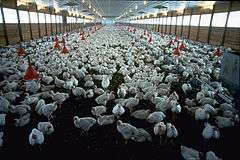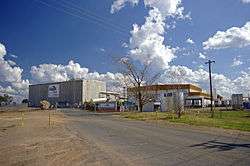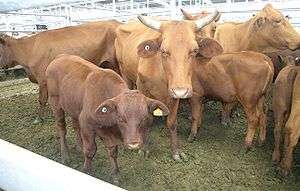Corporate farming

Corporate farming is a term used to describe companies that own or influence farms and agricultural practices on a large scale. This includes not only corporate ownership of farms and selling of agricultural products, but also the roles of these companies in influencing agricultural education, research, and public policy through funding initiatives and lobbying efforts.
The definition and effects of corporate farming on agriculture are widely debated, though most sources that describe large businesses in agriculture as "corporate farms" portray their role in a negative light.[1]
Definitions and usage
The varied and fluid meanings of "corporate farming" have resulted in conflicting definitions of the term, with implications in particular for legal definitions.
Legal definitions
Most legal definitions of corporate farming in the United States pertain to tax laws,[2] anti–corporate farming laws,[3] and census data collection.[4] These definitions mostly reference farm income, indicating farms over a certain threshold as corporate farms, as well as ownership of the farm, specifically targeting farms that do not pass ownership through family lines.
Common definitions
In public discourse, the term "corporate farming" lacks a firmly established definition and is variously applied. However, several features of the term's usage frequently arise:
- It is largely used as a pejorative with strong negative connotations.[1]
- It most commonly refers to corporations that are large-scale farms, market agricultural technologies (in particular pesticides, fertilizers, and GMO's), have significant economic and political influence, or some combination of the three.[5][6]
- It is usually used in opposition to family farms[7] and new agricultural movements, such as sustainable agriculture and the local food movement.[8]
Family farms
"Family farm" and "corporate farm" are often defined as mutually exclusive terms, with the two having fundamentally opposing goals.[11] This mostly stems from the widespread assumption that family farms are small farms while corporate farms are large scale operations. While it is true that the majority of small farms are family owned, many large farms are also family businesses, including some of the largest farms in the US.[12]
Additionally, there are large economic and legal incentives for family farmers to incorporate their businesses.[13]
Contract farming
Farming contracts are agreements between a farmer and a buyer that stipulates what the farmer will grow and how much they will grow usually in return for guaranteed purchase of the product or financial support in purchase of inputs (e.g. feed for livestock growers).[14] In most instances of contract farming, the farm is family owned while the buyer is a larger corporation.[15] This makes it difficult to distinguish the contract farmers from "corporate farms," because they are family farms but with significant corporate influence. This subtle distinction left a loop-hole in many state laws that prohibited corporate farming, effectively allowing corporations to farm in these states as long as they contracted with local farm owners.[16]
Non-farm entities

Many people also choose to include non-farming entities in their definitions of corporate farming. Beyond just the farm contractors mentioned above, these types of companies commonly considered part of the term include Cargill, Monsanto, and DuPont Pioneer among others. These corporations do not have production farms, meaning they do not produce a significant amount of farm products. However, their role in producing and selling agricultural supplies and their purchase and processing of farm products often leads to them being grouped with corporate farms. While this is legalistically incorrect, it is widely considered substantively accurate, because including these companies in the term "corporate farming" is necessary to describe their real influence over agriculture, just as in various industries regulating and taxing agencies do not allow treating all individual workers as "contractors" as a loophole for avoiding the employment standards and taxes that go with having employees.
Debates
Arguments for corporate farming
Corporate structure allows individuals to share in the ownership of agricultural land through buying shares directly or through their pension schemes. Land can be a useful source of stability for individual investors as it retains value over hundreds and thousands of years while other companies start, grow and die. Allowing individuals to share in the value of the land reduces the polarisation between land-owners, such as traditional aristocrats, and non-owners. Some would argue that the land of a country belongs, in some sense, to all of its citizens, because it is a natural asset that has existed forever rather than property created through skill by individuals; mass share ownership is a step towards this sharing.
Corporate structure encourages efficiency as the management is accountable to shareholders, whereas family farms may be managed for other objectives such as the enjoyment of the farmer or preservation of family wealth under special farm inheritance tax laws.
Arguments against corporate farming
Family farms maintain traditions including environmental stewardship and taking longer views than companies driven by quarterly profits. They are less likely to damage the land if they feel they are merely looking after it for the next generation than trying to extract every possible immediate profit. Detailed knowledge about soil and crop types, terrains, weather and other features specific to particular local areas of land can be passed from father to son over generations, which would be hard for temporary managers to grasp. Communists have argued that the land of a country belongs to all of its citizens equally, not through direct mass share ownership but by ownership through the state which represents them.
Unrestricted share trading of corporate farms allows the land of a country to be purchased by international buyers, which may present security and environmental risks when the buyers have different objectives from the country's own citizens.
North America
The 2012 US Census of Agriculture indicates that 5.06 percent of US farms are corporate farms. These include family corporations (4.51 percent) and non-family corporations (0.55 percent). Of the family farm corporations, 98 percent are small corporations, with 10 or fewer stockholders. Of the non-family farm corporations, 90 percent are small corporations, with 10 or fewer stockholders. Non-family corporate farms account for 1.36 percent of US farmland area. Family farms (including family corporate farms) account for 96.7 percent of US farms and 89 percent of US farmland area;[17] a USDA study estimated that family farms accounted for 85 percent of US gross farm income in 2011.[18] Other farmland in the US is accounted for by several other categories, including single proprietorships where the owner is not the farm operator, non-family partnerships, estates, trusts, cooperatives, collectives, institutional, research, experimental and American Indian Reservation farms.
In the US, the average size of a non-family corporate farm is 1078 acres, i.e. smaller than the average family corporate farm (1249 acres) and smaller than the average partnership farm (1131 acres).[17]
In Canada, 17.4 percent of farms are owned by family corporations and 2.4 percent by non-family corporations.[19] In Canada (as in some other jurisdictions) conversion of a sole proprietorship family farm to a family corporation can have tax planning benefits,[20] and in some cases, the difference in combined provincial and federal taxation rates is substantial.[21] Also, for farm families with significant off-farm income, incorporating the farm can provide some shelter from high personal income tax rates.[22] Another important consideration can be some protection of the corporate shareholders from liability.[23] Incorporating a family farm can also be useful as a succession tool,[24] among other reasons because it can maintain a family farm as a viable operation where subdivision of the farm into smaller operations among heirs might result in farm sizes too small to be viable.[25]
Europe
Family farms across Europe are heavily protected by EU regulations, which have been driven in particular by French farmers and the French custom splitting land inheritance between children to produce many very small family farms. In regions such as East Anglia, UK, some agribusiness is practiced through company ownership, but most large UK land estates are still owned by wealthy families such as traditional aristocrats, as encouraged by favourable inheritance tax rules.
Eurasia
Most farming in the Soviet Union and its Eastern Bloc satellite states was collectivized. After the dissolution of those states via the revolutions of 1989 and the dissolution of the Soviet Union, decades of decollectivization and land reform have occurred, with the details varying substantially by country. In Russia, some amount of family farming has developed, but many former collective farms (kolkhozy) and state farms (sovkhozy) retained their collective/joint nature and instead became corporate farms with stock ownership, the farmers having incorporated.
Africa
Corporate farming has begun to take hold in some African countries, where listed companies such as Zambeef, Zambia are operated by MBAs as large businesses. In some cases this has caused debates about land ownership where shares have been bought by international investors, especially from China.
Middle East
Some oil-rich middle east countries operate corporate farming including large scale irrigation of desert lands for cropping, mostly through partially or fully state owned companies. (citation needed)
Anti–corporate farming laws
To date, nine US states have enacted laws that restrict or prohibit corporate farming. The first of these laws were enacted in the 1930s by Kansas and North Dakota respectively. In the 1970s, similar laws were passed in Iowa, Minnesota, Missouri, South Dakota and Wisconsin.[26] In 1982, after failure to pass an anti–corporate farming law, the citizens of Nebraska enacted by initiative a similar amendment into their state constitution.[27] The citizens of South Dakota similarly amended their state constitution in 1998.[26]
All nine laws have similar content. They all restrict corporate ability to own and operate on farmland. They all outline exceptions for specific types of corporations. Generally, family farm corporations are exempted, although certain conditions may have to be fulfilled for such exemption (e.g. one or more of: shareholders within a specified degree of kinship owning a majority of voting stock, no shareholders other than natural persons, limited number of shareholders, at least one family member residing on the farm).[28] However, the laws vary significantly in how they define a corporate farm, and in the specific restrictions. Definitions of a farm can include any and all farm operations, or be dependent on the source of income, as in Iowa, where 60 percent of income must come from farm products.[26] Additionally, these laws can target a corporation's use of the land, meaning that companies can own but not farm the land, or they may outright prohibit corporations from buying and owning farmland.[28] The precise wording of these laws has significant impact on how corporations can participate in agriculture in these states with the ultimate goal of protecting and empowering the family farm.[29]
See also
Sources
- 1 2 Rumble, Joy N. (March 2014). "The Power of Words: Exploring Consumers' Perceptions of Words Commonly Associated with Agriculture" (PDF). Journal of Applied Communications. Retrieved 26 October 2014.
- ↑ "Farm, Farming and Who's a Farmer for Tax Purposes" (PDF). Rural Tax Education. August 2010. Retrieved 27 October 2014.
- ↑ Welsh, Rick (October 2001). "On the Effectiveness of state anti–corporate farming laws in the United States". Food Policy. doi:10.1016/S0306-9192(01)00020-3. Retrieved 26 October 2014.
- ↑ "Farm Household Well-being: Glossary". USDA Economic Research Service. 26 August 2014. Retrieved 26 October 2014.
- ↑ Wittmaack, Nathan (July 2006). "Should Corporate Farming be Limited in the United States? An Economic Perspective" (PDF). Retrieved 27 October 2014.
- ↑ Persaud, Suresh (16 April 2008). "Impact of Agribusiness Market Power on Farmers". doi:10.1002/9780470390375.ch7.
- ↑ "Corporate Concentration in Agriulture". Farm Aid. Retrieved 27 October 2014.
- ↑ Martinez, Steve (May 2010). "Local Food Systems: Concepts, Impacts, and Issues" (PDF). USDA Economic Research Service. Retrieved 26 October 2014.
- ↑ "Nunley Brothers Ranches: About". Retrieved 6 November 2014.
- ↑ Zeveloff, Julie (23 October 2012). "The 25 Biggest Landholders in America". Business Insider. Retrieved 6 November 2014.
- ↑ Stout, Jan (1996). "The Missouri Anti–Corporate Farming Act: Reconciling the Interests of the Independent Farmer and the Corporate Farm". Retrieved 27 October 2014.
- ↑ "Ag 101: Demographics". U.S. Environmental Protection Agency. 2012. Retrieved 27 October 2014.
- ↑ Patsche, Wanda (20 October 2014). "Family Farms vs. Farm Corporations". Minnesota Farm Living. Retrieved 27 October 2014.
- ↑ "Contract Farming Resource Centre: FAQ". Food and Agriculture Organization of the United Nations. 2014. Retrieved 27 October 2014.
- ↑ Warning, Matthew (30 June 2000). "The Impact of Contract Farming on Income Distribution: Theory and Evidence" (PDF). Western Economics Association International Annual Meetings. Retrieved 27 October 2014.
- ↑ "Anti–Corporate Farming Laws in the Heartland". Community Environmental Legal Defense Fund. Retrieved 27 October 2014.
- 1 2 United States Department of Agriculture. 2014. 2012 Census of agriculture. United States summary and state data. Volume 1. Geographic area series. Part 51 AC-12-A-51.
- ↑ Hoppe, R.A. 2014. Structure and finances of U.S. farms: family farm report, 2014 edition. United States Department of Agriculture, Economic Research Service EIB-132.
- ↑ Statistics Canada. 2011 Census of Agriculture.
- ↑ BDO Canada LLP. 2014. Tax bulletin. Incorporating your farm business. http://www.bdo.ca/en/Library/Services/Tax/Documents/Tax-Bulletins/Incorporating-Your-Farm-Business.PDF
- ↑ Alberta Agriculture. To incorporate or not to incorporate? http://www1.agric.gov.ab.ca/$department/deptdocs.nsf/all/beef11403/$FILE/to_incorporate_or_not_to_incorporate.pdf
- ↑ FBC. 2006. Off-farm income is reason to incorporate the farm. http://fbc.ca/knowledge-centre/farm-income-reason-incorporate-farm
- ↑ Ontario Ministry of Agriculture, Food and Rural Affairs. 2010. Farm corporations. Agdex 812; order 10-031.
- ↑ BDO Canada LLP. 2014. Tax bulletin. Succession planning for the transition of the family farm. http://www.bdo.ca/en/Library/Services/Tax/Documents/Tax-Bulletins/Succession-Planning-for-the-Transition-of-the-Family-Farm.pdf
- ↑ Farm incorporation has advantages and disadvantages. http://www.hth-accountants.ca/Files1/Articles/Article_files/WP2001-10-11/WP2001-10-11.htm
- 1 2 3 "Anti–Corporate Farming Laws". Encyclopedia of the Great Plains. Retrieved 27 October 2014.
- ↑ "Initiative 300: Nebraska's Anti–Corporate Farming Law". Center for Rural Affairs. Retrieved 6 November 2014.
- 1 2 "Corporate Farming Laws". National Agricultural Law Center. Retrieved 6 November 2014.
- ↑ "Corporate Farming (Restrictions on Corporate Farming/Family Farm Preservation)". National Agricultural Law Center. Retrieved 6 November 2014.
